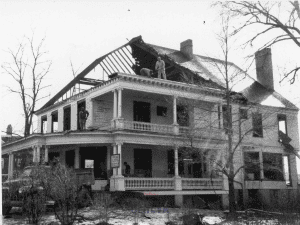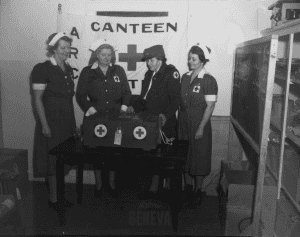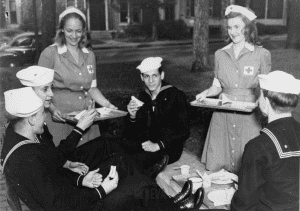Serving Troops on Route
By Becky Chapin, Archivist
In 1917, troops across America were on the move as they traveled to training camps and ports. Transportation difficulties and congestion at railroad junctions often made it impossible for soldiers to receive adequate meals prior to boarding. As a result, the US government requested the American Red Cross provide refreshments at railroad junctions.

The St. Stephen’s Parish House at 538 South Main Street was also the home of the Red Cross Chapter House. Pictured in 1957, it has since been demolished.
The Geneva Chapter of the American Red Cross organized their Canteen Service of women workers in March 1918 and assigned one woman per night to be in charge of the service and helpers. Initially, the plan was to meet soldiers at the Armory on Main Street, present them with cards of welcome and direct them on to St. Peter’s Parish House for use of showers, reading rooms, coffee, and food.
As the weeks went on, oftentimes the Canteen workers received almost no notice of troop arrivals. In April, members of the canteen committee received a phone call about the arrival of trucks that were coming from Canandaigua. Bad road conditions caused some strain on the trucks, so troops stopped in Geneva to repair them. Canteen workers arrived within five minutes of the troops’ arrival and started serving a luncheon.
The Canteen Committee requested community members donate old magazines and newspapers, short lengths of pencils, and supplies for serving such as teapots, plates, etc. In June, Mrs. MH Sandford, chairman of the committee, reported that in ten days they had served 13,600 soldiers at the railroad stations. The canteen also distributed soap, stamps, postcards, gum, matches, and chocolate. Sometimes they passed along fresh vegetables.
In the heat of July and August, the canteen was able to serve ice cream and soldiers were allowed to march to the lake to take a dip. The youngest member of the canteen service was Magdalene Castle who, at 2 years and 3 months, joined the service and worked the line with her grandmother giving out her homemade cookies, pies, and cigarettes.

Members of the Red Cross in front of the Canteen Corps flag, Mrs. WI Robson, Mrs. Lansing Hoskins, Mrs. Nathaniel Gardner, Mrs. Velma Ames, Mrs. Catherine McDonough.
Canteen workers saw anywhere from 600 to 700 men in each trainload and sometimes up to 1,000. In November, Mrs. Sandford opened a Hostess Hose in the president’s house at Hobart College. Books, magazines, sandwiches, coffee, and hot cocoa were provided to the men training at the Hobart SATC.
A year later, the Red Cross Canteen Cafeteria opened in the Hotel Algonquin on Seneca Street. Helen Moore was put in charge of the dining room which served tea and supper between 11 and 3:30. While I couldn’t find a reason why the cafeteria opened, it was likely a fundraising opportunity for the Red Cross and a chance to increase membership.
The Geneva Canteen Committee stopped its services around 1919 and reopened again in 1942. The canteen service picked up where it left off, quickly finding stationary kitchens across Geneva including their Chapter House in St Stephen’s Parish House, Main Street, and at the First Presbyterian Church. A new chapter, the William Smith College Canteen, was formed by women in the college.
In this revival, the Canteen Corps expanded its services. Their objectives included training for providing emergency family and group feeding in situations caused by disaster or war and to provide organized volunteer workers for the Nutrition Committee of the Chapter and for the county and local Nutrition committees appointed in defense areas. In addition to meeting troop trains, they would also serve refreshments to blood donors when the American Red Cross mobile unit came down from Rochester, serve at luncheons for special events, and at the USO on Main Street.
In 1943, students in the Geneva High School manual training class designed and built a mobile kitchen to donate to the Red Cross Canteen Corps. The students mounted it on a Cadillac chassis and constructed the trailer with a natural wood finish on the inside and olive drab on outside with an opening on the side for serving, measuring 16 feet long, 7.5 feet wide, and 9 feet high.

Supper was served in Pulteney Park from the Red Cross Canteen mobile unit to Navy men from Sampson. Molly Wilson and Sally Burrall Nagel serve sailors, c. 1944.
A report for the month of June showed 165 workers working 346 hours with a total of 11,016 people served through all Canteen services. In July, it served 15,907 people.
Members were sourced out when the Geneva High School cafeteria was without workers due to illness and other reasons. The Home Economics teacher called the canteen chairman, Mrs. Cecil McKay, who rallied her members to prepare a lunch for about 500 students by noon. They were prepared to stay on until the workers could get back on the job.
On November 30, 1944, a blizzard caused blockages on the highways. Recruits coming on a Lehigh Valley Railroad train arrived en route to Sampson after spending the night on the road with no breakfast. Mrs. Cecil McKay and Jane Stauff, with the Red Cross Motor Corps, were contacted and arrived at the station to find servicemen and hungry civilian travelers, a total of 450 people. Through numerous trips to the USO, canteen workers were able to feed everyone and provide hot coffee and cigarettes to the servicemen.
The canteen service continued after the end of World War II, assisting with the blood donation programs and providing picnics and teas for patients in veterans’ hospitals. It picked up regular training in 1950 and provided canteen service to troops passing through. On January 7, 1952, a string of convoy trucks started arriving in Geneva about 1:30 pm and continued until 5 pm, with more trucks expected in the following several days. The Canteen workers served coffee and sandwiches to the units on their way to Sampson.
Not much was mentioned about the canteen service after 1954, but there were many hard-working women behind the efforts. Based on listings in the newspaper, I estimate there were about 700 women involved with serving in the local Red Cross Canteen from 1917 to 1954.
This article was brought to you in part by our supporters. Be our partner in telling Geneva’s stories by becoming a Historic Geneva supporter.

Becky, Another great article with great information.
Very interesting and informative blog about the Geneva Red Cross’ work during the wars.
They were doing a wonderful job to feed all these soldiers.
Thank you, Becky